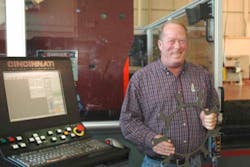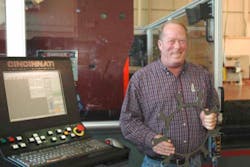Doubling laser cutting productivity
As the old expression goes, something’s gotta give. Combined vertical and horizontal growth from new and expanding markets left irrigation systems leader Lindsay Corporation needing greater metal cutting capacity and fabrication throughput from its available manufacturing space. The company found the solution in a Cincinnati CL-850 laser cutting system, combining higher power and speed with a dual-pallet work changer.
Lindsay has grown over the past half century into a global leader in irrigation systems that optimize plant yields and the use of scarce, precious water. Its GPS-directed, center-pivot and mobile lateral-move irrigation systems use water and labor more efficiently than conventional “flood” or “surface” irrigation systems. Lindsay’s core business outlook remains strong and growing, as climate change drives domestic and international demand for efficient irrigation systems.
At the same time, Lindsay has expanded into new businesses to leverage its broad manufacturing capabilities. The company is building a blue-chip portfolio of contract manufacturing business with major OEMs, particularly among leading agricultural and construction equipment companies. One such relationship led them in 2006 to acquire Barrier Systems Inc., a manufacturer of moveable safety barriers for highway traffic management.
Faced with accelerated growth from expanding business lines, Lindsay engineers recognized the need to significantly increase throughput, efficiency, and flexibility in fabricating sheet and plate components at its Omaha-area plant. One immediate requirement was increasing its laser cutting capacity, says Jim Belzer, manufacturing engineer.
Lindsay evaluated different laser cutting systems and found the best fit for its requirements was a high-speed, 5000W CL-850 laser cutting center from Cincinnati Incorporated, Cincinnati, OH. “We were looking for speed and the greatest range of cutting thicknesses since we do not know ahead of time what parts our customers might be sending us,” he says.
The Cincinnati laser doubled productivity compared to a previous cutting laser, according to Belzer. It does this by providing advantages in key areas targeted by Lindsay planners.
The 5000-watt GE Fanuc laser resonator enables Lindsay to cut plate up to ¾ in., compared to ½ in. maximum for the earlier laser. This allows the company to transfer work to the Cincinnati laser that formerly was plasma cut, says Belzer. The company’s material processing needs typically range from 20 gauge up to 0.75 inch, while the laser is rated for handling up to 1.125 inch mild steel. “The Cincinnati laser is much faster than plasma cutting, plus it gives us superior edge quality,” he adds. Plasma-cut plate typically requires post-process deburring or machining, adding throughput time, labor cost, and more complicated work scheduling. A next-generation cutting head on the laser gives superior edge quality with AutoFocus lenses of 5, 7.5, and 10-inch focal length. The lenses allow the focus points to be instantly adjusted--especially between piercing and cutting--for optimal processing of various materials. A new height sensor, insensitive to plasma, enables much higher feedrates on thin metal using N2 or air assist gas.
“The key benefit is throughput,” stresses Belzer. That’s because Lindsay has combined the laser with a robotic welder in a processing cell,” he explains. Work can feed directly from the laser to the welder, while the precision and consistency of laser cutting ensure optimal fit-up of parts for welding. “Our goal was to minimize processing time and material handling, and that’s what happened," he says.
High speed processing
The CL-850 features a third-generation linear motor drive, which combines with greater cutting power to allow faster processing, especially on thinner sheet materials. For example, Belzer notes processing time has dropped by more than half on galvanized steel for irrigation system control panels. Laser cutting eliminates hard tooling for such parts, which have a number of cut-outs, he adds.
Dual quick-change pallets enable the off-line pallet to be loaded and unloaded while work on the other pallet is being processed. Pallet change now takes just seconds, enabling almost non-stop cutting efficiency. By comparison, explains Belzer, the previous single-bed laser needed to be stopped each time for removal of finished parts and reloading for the next cutting cycle.
Lindsay’s plant runs three shifts per day, six and one-half days per week, and the laser has lived up to expectations in supporting this level of productivity. “Performance and reliability of the machine have been excellent,” says Belzer. Several hundred different part numbers are processed by the laser, about 95 percent in mild steel, primarily ¼ in. material or thinner.
Lindsay machine operators perform programming of parts and jobs. According to Belzer, programming is a snap. “We download AutoCAD drawings directly from our mainframe to the laser,” he says. The laser’s nesting software is then used to batch parts for maximum material yield. The laser processes four different material thicknesses in a typical shift, allowing versatility of scheduling and enabling nesting and batch processing of common thickness parts.
Founded in the early 1950s, Lindsay Corporation takes its name from its hometown, Lindsay, Nebraska, with a population of 250, or about half the size of the company workforce. A publicly traded company (NYSE: LNN), it is a global leader in advanced irrigation systems for agriculture, turf, commercial, municipal, and residential applications. Its Zimmatic agricultural irrigation systems make farming more productive for farmers in more than 90 countries. Through its acquisitions in the U.S. and Europe, Lindsay also has become a major provider of highway traffic control products.
The company’s ability to combine automation and quality control with a highly motivated workforce has enabled it to grow into a preferred supplier for contract manufacturing as well. The laser cutting system and sheet metal processing cell further strengthen Lindsay’s ability to respond to these growing business opportunities.
For more information about Lindsay Corporation, contact the company at www.lindsay.com. For more information on Cincinnati Incorporated’s laser cutting system, visit its web site at www.e-ci.com.

